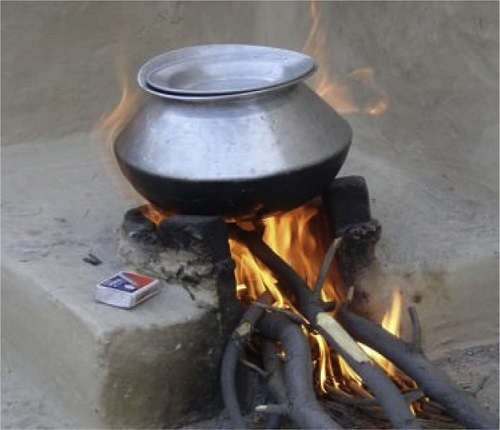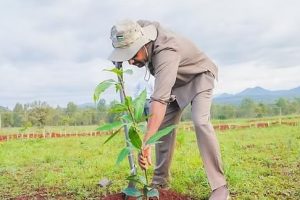
Zenebu Abraha and her family live in Tsetsera, Raya Alamata Woreda of Southern Tigray Zone, and a village found around 8 kilometers from Alamata town. Zenebu’s village has no access to energy. As a result Zenebu and her neighbors have to burn firewood for all sorts of cooking and lighting.
Fatuma Idris and her three family members live in Shebel Kebele, Shebel Berenta Woreda of Eastern Gojam Zone of Amhara State, few kilometers away from Bichena town. Fatuma’s village also has no access to electricity.
“We have to trek up to an hour and spend three to four hours collecting firewood in the dense forests and return home carrying the wood on our back and shoulder” said Fatuma describing the backbreaking work of women in rural neighborhoods.
Zenebu also said “women are responsible to collect wood in our village traveling kilometers.” Both Zenebu and Fatuma stated that they spend up to half a day in collecting the firewood at least twice or three times a week.
According to the Ministry of Women, Children and Youth Affairs due to lack of access to technological advancement, women like Zenebu and Fatuma spend about 14 hours a day on average carrying out unpaid and tiresome household chores, collecting firewood, fetching water from rivers and cooking food for the household.
Minyamir Yitayew, Women Capacity Building Team Leader at Ministry of Women recently told The Ethiopian Herald that Ethiopian women in the rural areas spend most of their time undertaking non-paid routines which affect the households’ income and the country’s economy. For him, if one percent of women in the country engage in paid jobs, the country’s GDP would increase by 0.02 percent. But, most women in Ethiopia, especially rural women spend their time on unpaid jobs.
According to a research conducted by Ethiopian Public Health Institute, as over 64 million Ethiopians depend heavily on solid fuel for daily household energy needs, over 67 thousand deaths attributable to household air pollution in 2019 which could be averted by having electricity access.
According to Ministry of Water, Irrigation and Energy though over 29 million students are attending schools across the country, two-thirds of them have no access to electricity. This forces them to do their homework and study using firewood, candle or torch light during the evening. This is dangerous for their health as it exposes them for respiratory diseases and sight impairment.
To solve energy problem, Ethiopia launched National Electrification Program aiming at realizing universal energy access by 2025. The goal of the Electrification Program is to reach every household to have energy by 2025.
With the aim of achieving this huge plan, Ethiopia is investing heavily on hydro, wind, solar and geothermal energy investments, including facilitating the completion of the Grand Ethiopian Renaissance Dam (GERD). By 2025, Ethiopia’s goal is universal energy access to cover 65 percent with grid and 35 percent with off-grid energy. This 35 percent off-grid energy covers around six million households in remote and scattered rural villages.
Ethiopian-German Energy Cooperation organizes 2021 innovation competition on decentralized energy solutions in rural Ethiopia aiming at promoting local innovations on off-grid energy solutions.
Kamil Dino (PhD) and Nigussie Wondimu are Mechanical Engineers and are among the 2021 energy innovation competition finalists vying to realize their business and innovational ideas.
After graduating with Bachelor’s Degree in Mechanical Engineering from Addis Ababa University Nigussie was engaged in energy business for some three decades. After all the experiences, he started importing solar energy four years ago.
Nigussie told The Ethiopian Herald he realized the problem of the rural community for energy source after he started importing solar energy products. He then decided to work on to reach more people. Now days, the limited access to foreign currency poses formidable challenge even to expand the importation of finished solar products which is also very expensive to the rural population. Then, Nigussie planned to install solar energy assembling factory at home. Yet, his plan was stalled by shortage of working capital.
Fortunately, Ethio-Germany Energy Cooperation – 2021 energy innovation competition stepped in to support best innovative ideas. Nigussie presented his proposal to the innovation competition and is now among the ten finalists after many rounds.
According to Nigussie, currently there is only one Solar products assembling company in Ethiopia based in Bahir Dar, yet the solar energy demand in Ethiopia is untouched. Not only that, due to foreign currency shortage, importing solar products is also expensive and tough which also makes the local market unaffordable for the rural population.
Furthermore, products with unknown producers are smuggled in to the country affecting users rights of access to quality and standard products as well as after sales service, according to Nigussie. To solve this problem, by importing the basic components and materials, he plans to install the factory which helps technology transfer, access to quality products with affordable price and providing maintenance or after sales service.
For him, if he finds the working capital and land, his proposal is easily realizable and the assembling factory is not as such complex. In addition, if he wins the innovation competition get support and connections with foreign companies, the assembling plant can become real within two-three years, with around one million birr working capital.
His idea is to manufacture selected products at home and by importing the major components, to assemble solar products with high quality considering suitability with Ethiopia’s weather and nature.
Kamil Dino (PhD) is an Assistant Professor at School of Mechanical and Industrial Engineering, Addis Ababa University Institute of Technology. He spent the past ten years on teaching most of the time renewed energy courses and researching on energy sector. He innovate a modern cooking stove with his friends, which improves thermal efficiency and emission reduction potential of micro-gasifier.
Dr. Kamil with his friends published a research paper with natural draft micro-gasifier 2017, a cooking stove. As pilot level, they manufactured the first product at the university’s laboratory. Then, they continued their research and added a fan to the improved stove, the thermal efficiency increased. The traditional cooking stove’s energy efficiency using solid-fuels is 10 percent while the improved stove of his innovation improved the thermal efficiency to 45 percent.
By developing his research, Kamil is competing at the 2021 innovation energy competition to implement Integrated Energy Domestic Unit to provide light, charging service and cooking by connecting solar Photovoltaic (PV), micro-gasifier (locally supplied improved stove) a fan with charger. PV is the conversion of light into electricity using semiconducting materials that exhibit the photovoltaic effect, he defined on his paper.
By integrating these products, Dr. Kamil said, it helps households to get complete energy solutions, charging, light and energy for cooking. The stove is a locally produced and the pilot product is already manufactured, waiting only capital to produce for market purpose. To produce the improved stove, it needs small factory at home and the other materials to get from the market. In this case, we are thinking to work with Nigussie’s company if they start assembling solar products.
According to Kamil integrating these products is not complicated since the major product is “our own product to supply locally.” Implementing this energy combination helps the rural population to save wood by reducing the energy wasted during cooking, reducing emission and to get complete energy access.
Both Kamil and Nigussie argued that they have the experience, the idea, the business proposal and the motivation to realize their innovations, the remaining challenge is the working capital and land.
According to Kamil, over 85 percent of the population is using fuel and other nonrenewable energy sources especially for cooking purposes while 90 percent of the thermal energy efficiency of the traditional cooking system is wasted.
Nigussie also argued that his project “is 100 percent achievable, attainable and realistic” and hopes to provide standard products to the emerging solar market demand in Ethiopia.
The vision of both engineers is to contribute their own share for the realization of the 2025 universal electric access in Ethiopia by supporting the off-grid energy development with their new innovations and business activities. Parallel to that the vision of these innovators is to create job opportunity, to save the country from foreign currency and to support the country’s technology transfer, in addition to expanding their businesses.
BY DARGIE KAHSAY
The Ethiopian Herald June 2/2021





